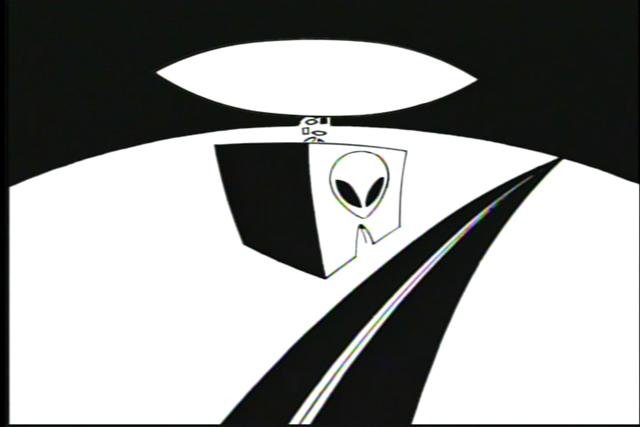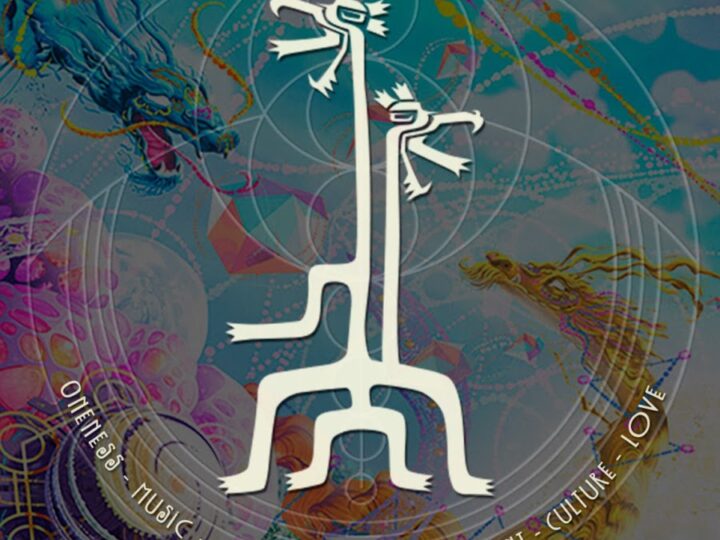
A UFO Epistemology
If we’re to believe our ancestors, close encounters with the gods are no joke.
Even if they beam down in a celestial glow, they still scare the shit out of
everybody. And more often than not they lurk on the edge of revelation, in the
outer dark, where the firelight is swallowed in gargantuan night.
Today our fires are so bright—the skeptical lights of labs, satellites, and
TV cameras—that such entities would need to go guerilla to penetrate our
glaring reality. They’d contact us only to baffle: swooping down on isolated
individuals, transmitting puzzling messages, or sowing seeds of impossibility.
Then they’d disappear into an ontological quagmire, attracting only those
foolish or hopeless enough to exit the magic circle of mundane identity for a
dizzying wormhole of perverted science, of cheesy synchronicities and
information trails that loop back on themselves.
In short, they would act like UFOs.
The UFO is an enigmatic rent in the fabric of the 20th century, and all our
explanations are signals shot into the heavens—they either fade into the
stellar maw or bounce back, echoes of our own descriptions. By remaining beyond
reach, by remaining absurd, the UFO attracts our hidden-most obsessions with
scientific authority, state power, and spiritual futurism—and it demarcates
these obsessions far more viscerally than more normal forms of popular
culture.
UFO literature, by drawing curious readers into bizarre worldviews shored up
with the language of evidence, shows how our attitudes toward information
structure our reality and identity. Even if the UFO is bunk, it has become
modernity’s great mythic mirror. The first “flying saucers” were sighted in
1947 by Kenneth Arnold, in the year that gave us the CIA and information
theory, in the decade that gave us TV, the Bomb, digital computers, and LSD.
The UFO is part of a package deal—a rumor of god stitched into the dark web of
our military-industrial-media complex.
Though habitually keeping a low profile, the visitors have been pretty busy
since ’47. The UFO and its trickster crew have crash-landed, pulled fly-bys,
delivered messages of doom and gnostic salvation, sucked bovine blood,
conspired with the Air Force, stolen embryos from Middle American housewives,
fucked Brazilian farmers silly, and rammed anal probes into horror fiction
writers. But though millions believe, and many more are cautiously credulous,
the aliens remain beyond reach, in a netherworld of bad films, paperbacks, and
late-night testimonies. Sightings haven’t really made news since the ’70s and,
though Whitley Streiber’s 1987 Communion ruled the charts, the UFO
seems almost quaint in our cyberpunk world, a cosmic VW bug in the weedy back
yard of modernity.
But the UFO has not waned so much as gone within, into the body, into the
mind, into the dream of identity. Thousands of abductees, seeking to ease the
psychic trauma of being dragged onto spaceships and physically abused by
aliens, have solidified a sub-culture that’s far more 12 Step than Star Trek.
Conspiracy theorists weave UFOs into their insidious webs of government plots,
while channeled ET info has evolved into the New Age’s most speculative edge.
And after years of cranky pursuits for the “nuts and bolts” that will prove the
existence of material extraterrestrial spacecraft, some ufologists are turning
towards a subtler engagement of the alien as radical mythic enigma.
But setting UFOs alongside sewer alligators and superheroes as “modern myths”
is boring—not because UFOs are boring but because our contemporary sense of
mythology is. We forget that the first mythologists ran into camp with eyes
bugging, babbling and pointing at that thing out there. Cook
such testimonies down far enough you get Disney morality tales, but when served
raw they glisten with awe. As Carl Jung wrote in his odd, prescient 1959 study
Flying Saucers, “in religious experience man comes face to face with a
psychically overwhelming Other.” Even for the nuts-and-bolts crowd, the
overwhelming strangeness of the UFO makes it a fundamentally spiritual object.
Holy, violent, and utterly goofy, the alien is the ultimate identity crisis.
***
Problem is most of us haven’t left the fire. We have not seen glittering
diaphragms whipping through the skies. We have not been abducted by little blue
dudes in shiny overalls. All we have are texts. Having recently devoured a
stack of UFO lit, I can attest that the stuff follows the law that applies to
everything from kinky sex to paranoia: the more you slum, the more it begins to
stick. You start with the innocent act of just believing that folks aren’t
lying or hallucinating—definitely a counter-hegemonic move when its a
trucker’s word against a physicist’s. But where do you go from there? Step in
any direction, and the landscape starts to melt.
As Keith Thompson points out in his smart if sometimes breezy Angels and
Aliens: UFOS and the Mythic Imagination, in the end the UFO is nothing more
than our attempts at interpreting it. Recognizing that each hypothesis is “a
particular and limited question put to the UFO by particular observers with
particular assumptions,” Thompson shows that mainstream ufology’s grail of
physical evidence is not only boring but moot. Far more interesting to engage
our own reflections in those almond-shaped white-less eyes that peer back from
so many paperbacks.
So with a judicious use of Angus Fletcher’s great Allegory, along with
dips into Kafka, Gregory Bateson, and Camus, Thompson reads the history of
ufology as a series of primal scenes that provoke hermeneutic battles. He shows
that UFO phenomena are structured like open-ended allegories, their power
resting neither in baroque surface details nor some underlying code of paranoid
explication, but in the protean tension between the two. Since aliens are
encountered not in frescoes but in wheat fields, Thompson locates this mythic
indeterminacy in the unfolding boundary between mind and matter. Picking up on
the pioneering work of Jacques Vallee, he sees the alien as the latest in a
procession of ghosts, Blessed Virgins, leprechauns, and all the other critters
you read about when you were 11 and the world was not a closed book. But rather
than pin the UFO as the latest butterfly from Faerie, Thompson points out that
these entities always slip through the fingers of our perception and
understanding. Their very being is a bizarre, nauseating blur, as if their sole
purpose were to yank the reality rug from under us.
***
If interpreting the alien leads us only further into the mind’s house of
mirrors, experiencing aliens is another story entirely. As portrayed in
Streiber’s pulpy and compelling Communion and Transformation,
and catalogued more paranoically in Budd Hopkins’ Missing Time and
Intruders, the act of being interdimensionally sucked into
claustrophobic smelly rooms by expressionless gray aliens with needles is no
party. Not only do aliens violate the bodies and minds of abductees, they
shatter their very identities. As Streiber tells it, “Whitley,” after being
drawn up into some foreboding round room, “ceased to exist. What was left was a
body in a state of raw fear so great that it swept me like a thick, suffocating
curtain…I do not think that my ordinary humanity survived the transition to
this little room. I died, and a wild animal appeared in my place.” The aliens
proceed to jab a hair-thin needle up his nose into his brain, lay him on an
operating table, take a foot-long object”gray and scaly, with a sort of
network of wires on the end”and invade his asshole.
That Streiber is a well-read student of the weird and a horror fiction writer
detracts not one whit from the power of his books. The thousands of letters he
received and the support groups that followed in the wake of Communion‘s
success validate the emotional trauma he described more than polygraphs ever
could. As Streiber writes of of abductees in his “prelude,” whatever we choose
to believe about what actually happened to them, “scoffing at them is as ugly
as laughing at rape victims.”
The analogy is no joke, for the abduction phenomenon clearly arises in part
from contemporary obsessions with violation, specifically the talk-show trade
in tales of ritual child abuse and, more subtly, of incest. As with many of
these narratives, recollections of ET nastiness are usually uncovered from
behind thickets of denial and “screen memories” (the psychological equivalent
of an Air Force cover-up). Much of this essentially ambiguous evidence is
ferreted out by sympathetic therapists using hypnosis and other probes. Also,
in attempting to manage their lingering terror, anger, and shame, as well as
their despair at not being believed even by their family and friends, abductees
have banded together into tight-knit support networks that, by accepting the
validity of their experience, perpetuate it as well.
Though some abductees climb the 12 steps to God following their trauma, many
buy into Budd Hopkins’ dark-side view of the aliens as nefarious and physically
real embryo stealers who need human genes to graft into their own thinning
stock. A cheap SF plot for sure, but as images of racial otherness are spliced
together in the great Michael Jackson video of multinational culture, it’s
interesting that terrified humans should encounter the greatest miscegenation
since mythic times, when the swan took Leda and the fallen angels raped the
daughters of men. And it’s all too appropriate that Betty and Barney
Hill—whose 1961 encounter is generally treated as the first modern case of
abduction in the U.S.were an interracial couple. The notion of alien hybrids
amps the cultural and genetic scramblings of interracial couplings onto the
level of human being itself. Between DNA manipulations, penetrated flesh, and
the stark terror of a ruptured reality, the extremity of the abduction
experience throws identity not just into question, but into the abyss.
***
Though the abduction phenomenon points toward the slippery realms of waking
dreams and mass psychology, the majority of UFO researchers remains beholden to
the dogmas and rituals of hard physical science. These nuts-and-boltsers aren’t
interested in faeries or psychobabble—they want testimonies, burned turf,
weird rocks. They want information. Marginalized from the legitimacy and cash
conferred by institutional research, they desperately want to normalize the UFO
into a legitimate object of study. They don’t want to hear that their urge to
prove what they call the “ETH” (extraterrestrial hypothesis) using the tools of
science is just one more metaphysical compulsion set before the feet of a
radical enigma. They don’t want to hear that busting science moves like graphs,
credentials, acronyms, and the language of hard evidence (dates, exact times,
measurements) is just a fetish in the face of the void.
As solid, investigative pseudoscience, the nuts-and-bolts stuff can be as fun
as it is cranky, if only because the best works mutate the authority of
scientific style by soberly fusing cosmic speculations and legitimate hard
science. Most scientists hate this material not just because they’re trained
to, or because they think the world is too dull for ETs (far from it), but
because pseudoscience has a dangerous tendency to encourage us proles to jump
the fence of technical languages and sneak around the arena of Truth. Dipping
into UFO studies is a great way to experience the subtle and pervasive powers
of scientific hegemony.
It’s a deep comment on contemporary forms of knowledge that, in their drive
for literal resolution and their obsessions with institutional authority,
mainstream ufologists are drawn like bugs into conspiracy theory. The grassy
knoll in this case is the Roswell Incident, a 1947 report of a crashed saucer
that was announced by the Air Force and later retracted. Like JFK assassination
material, UFO cover-up lit draws you into a magnetic vortex of marginal
information. As Whitley Streiber put it, “I found myself in a minefield. Real
documents that seemed to be false. False documents that seemed to be real. A
plethora of ‘unnamed sources.’ And drifting through it all, the thin smoke of
an incredible story.” Convincing stuff like Timothy Good’s Above Top Secret:
The Worldwide UFO Coverup leads to wacky stuff like We Discovered Alien
Bases on the Moon. Your formerly arched eyebrows start to scrunch into a
suspicious scowl. And once you accepted the existence of disinformation and the
subsequent likelihood that most debunkers are agents, it’s too late.
You’re gone, sucked out of consensus reality into the black voids that mark up
FOIA documents, energized only by your rumor jones and your tangled
relationships with other buffs.
In the information age, marginal data and rumors sipped from underground
springs can bend the mind as decisively as any drug. In the case of the UFO,
they can take you about as far out as you can go without invoking God-talk. For
example, there’s William Cooper’s deliriously fun and patently mad Behold a
Pale Horse , a self-published tome that weaves together crashed discs,
“Nordic” aliens, and the Illuminati. Besides reprinting that chestnut the
Protocols of the Elders of Zion, Behold a Pale Horse comes stuffed with
aerial recon photos, government documents, and fuzzy mimeographs. Much of this
material concerns a major fixation of the dark-side UFO web-weavers: the
mysterious Area 51 at Nellis Air Force base in Nevada, where aliens from Zeta
Reticuli are supposedly trading tech with the government in exchange for the
right to rip off our genes.
Research long enough and you might even score a visit with one of the UFO
drama’s greatest figures: the dreaded Men In Black (known, of course, as MIB).
Often hounding UFO researchers, MIB show up in black caddies, dressed in
immaculately creased G-men suits, white shirts and shades. They proffer false
ID, and proceed to either extract information from witnesses or threaten them
into silence, speaking in stiff, monotonous phrases copped from bad noir. Just
to compound the strangeness, MIB are often described as “swarthy-skinned” and
almond-eyed—thereby crossing non-white “alien” qualities with the purest
archetype of the white man’s systematic control. In the UFO realm, otherness
is so protean it becomes its own other.
***
Though motivated by the quest for hard information, conspiracy weaving
ultimately becomes more akin to rosary counting. In his—and it’s usually
his—totalizing view of events, the paranoid is only the most rigorous of
metaphysicians. Both the esoteric and the crudely popular tendencies of Western
religions encourage this divine paranoia. Jewish kabbalists have read Genesis
as a code whose letters conceal secret messages, while Satan-fearing Christians
have used the Book of Revelation as an interpretive gloss on current events
from over a millennium.
In the spectrum of cosmic conspiracies, halfway between God and Darth Vader
ETs lies what one could call the Starseed take on human history. Typified by
Erich von Daniken’s ’70s pot-boiler Chariots of the Gods?, this view
holds that ancient pagan sky gods and Biblical oddities like Ezekiel’s chariot
are UFO phenomenon, suggesting that human consciousness was implanted or at
least nudged toward civilization by visiting ETs. Much better than Daniken’s
books is Robert K. G. Temple’s astounding The Sirius Mystery, which
rigorously directs academic methods toward totally wacked conclusions about
beings from Sirius, the ancient Egyptians, and the Dogon tribe in West Africa
Temple fuels his research with the dusty synchronicities that spending too much
time in libraries can produce, demonstrating that the tools you rely on to
hammer the world together can just as easily yank the nails out.
As captured so well in Robert Anton Wilson’s classic counter-cultural wild
ride Cosmic Trigger: Final Secret of the Illuminati—which connects
meddling Sirians with Aleister Crowley, Tim Leary’s Starseed prison visions,
and the strange recurrence of the number 23catching the eye of the pyramid
has a lot to do with your attention, with consciously tuning into coincidences
and weird information sources (odd books, dreams, drugs, incantations) until
glittering patterns emerge. The challenge is that unless you want to get
slurped into what Wilson calls a “reality tunnel” and wind up carrying a
sandwich board, you must adopt a kind of a bemused schizophrenia, a yin/yang of
skepticism and lucid madness. About the only concrete thing Whitley Streiber’s
doctors could suggest to him was that he learn to live with a high degree of
uncertainty. Not a bad postmodern prayer.
***
In the end, most UFO theories—Air Force cover-ups, Sirius acid jokes,
channelled New Age messages, the cranky ETH—can be seen as different modes of
structuring the information that crusts around the slippery edges of a massive
enigma. Even mainstream science’s sop to ETs—SETI, the big dish search for
intelligent radio signals in deep space—reflects the faith that signals can
always be untangled from noise. Taken to its extreme, this information theory
becomes information mysticism, a giddy flux that runs through one of the most
universally reviled literatures currently produced anywhere: New Age
channeling.
The genre isn’t exactly new–in America, such practices stretch back at least
to the early 1800s, when Shakers went into trance and brought forth the spirits
of George Washington, various Native Americans, and other wisefolk. It was only
after TV that such spiritualism became “channeling.” Nor is god-talk from ETs
particularly novel. Aleister Crowley, every rock star’s favorite occultist,
contacted a Sirian named Lam in 1919; in the ’50s, blond Space Brothers
delivered cosmic greetings to loons like George Adamski; the ’70s saw an
explosion of UFO churches. But these days the spiritual UFO hovers over
the much larger carnival of the New Age, a synthetic stew of archaic gods,
pagan lore, watered-down theosophy, pseudoscience, and therapy jargon.
For example, Michele Jamal’s New Age quest narrative, Volcanic Visions:
Encounters with Other Worlds, begins far from the cold reaches of space,
in the sensuously conjured environment of Hawaii, where Jamal lets her earthy
fascination with the fiery volcano goddess Pele run wild into a hodgepodge of
horny dreams, “post-patriarchal” myths, and zoned-out nature walks. But then
she awakens from a dream of Kilauea and flying saucers, and switches to tech
talk: “The thought came to me that somehow information had been transmitted
through my neuro-circuitry.” What’s a girl to do but go to Michael El Legion, a
visiting channel from the Extraterrestrial Communications Center in Arizona,
who dutifully channels Ashtar, member of the Universal Federation.
Like most channeled entities, ETs like Ashtar, Bashar, and the aliens who pop
up in Lyssa Royal and Keith Priest’s Visitors from Within speak in
the New Age pastel blend of positive-thinking therapy talk. But these ETs are
more fun because they give it all an SF twist, going on about alien sex rites
and ET taxonomies—the loving Arcturians, the meddling Zeta Reticuli, the
mystical Sirians, the nasty Orions—while chanting a techno poetry of “Harmonic
Wave Templates” and “Polarity Resonance Manifestations.” But the underlying
message remains the New Age’s great rallying cry: you create your own
reality. A mantra for the privileged to be sure, yet in the hands of a
wiseman like Bashar—who claims to be a human/Zeta Reticuli crossbreed blasted
back from the future—this heretical one-to-one identification with the Creator
achieves a seductive force that can worm its way into your brain. “Personality
is an artificial construct,” Bashar proclaims, asserting that since reality is
keyed to malleable filters and belief structures, we can change our experience
as easily as twisting the dial.
In part, the bubbly weightlessness of the New Age’s extreme positive-thinking
arises from an identification not with matter or the socio-political inertia of
human history, but with the instantaneity and immaterial flux of information.
Metaphors of info-tech abound in the New Age. If monotheistic faiths are
religions of the book, then the New Age is a religion of the byte. At the same
time, such on emphasis on divine data also resurrects musty myths of stellar
origins that can be traced back to ancient gnosticism. In the gnostic view, the
true god—not the false god Jehovah—is an alien being whose sole connection
with the fallen, material earth is the “sparks” or “seeds of light” hidden
within the human soul. We are not sinful, just ignorant, lost in a forgetful
sleep that can only be banished by receiving the mystical influx of alien
information, or “gnosis.” Only then will our homesickness be assuaged.
True to its gnostic character, channelled ET material is structured more
like a virus or a trigger signal than a set of beliefs. This rhetoric of
immediacy is most obvious in the pervasive use of the second person, which in a
powerful work of SF Christianity like Ken Carey’s The Starseed
Transmissions becomes the literary analog of the Zeta Reticuli’s sharp
needles—only instead of your brain, the entities invade the seat of your
“you”. “It is critical that you remember your origin and purpose. Your descent
into Matter has reached its low point. If all that you identify with is not to
be annihilated in entropic collapse, you must begin waking up, begin living.”
Carey and others attempt to create a flip-flop at the slippery edges of
identity (“you are not the form you animate, but the force of animation
itself”), transforming alienation into a sense of alien mission. Compared to
the paranoiac Budd Hopkins, New Agers accept this cosmic mutation with open
arms. So you get wonderfully weird texts like the self-consciously humorous
E.T. 101: The Cosmic Instruction Manual, An Emergency Remedial Edition,
a spiral-bound notebook directed at those aliens who have incarnated on earth
and are just beginning to wake up to their true origins and original mission
now that “third-dimensional reality is up for grabs.”
What’s the mission? To spread the millennialism at the heart of information.
At the wacko fringe of a wacko phenomenon, you find a mutant equivalence of
identity and information, as if the glut of data and images that continues to
rewire the postmodern subject is only the leading edge of a much greater
transformation. Though characterized in many ways, the new space we are moving
toward is the space of information itself—nonlinear, disembodied, complex,
synthetic. Bashar calls it the “fourth density,” wherein one experiences that
“everything is interconnected holographically; everything is the same one thing
manifesting in all the different, multi-faceted, multi-dimensional ways that it
can—simultaneously.” In one of The Starseed Transmissions‘s most
remarkable passages, the channeled beings say of their gnostic proclamations:
“This new information is not additional data that you will act upon. It is,
rather, the very reality of your new nature. You are not to act upon my
information in the future, you are to be my information yourselves.” These
alien angels are telling us something computer junkies already know: the degree
to which we truly live in cyberspace is the degree to which we identify
ourselves with information. Perhaps the UFO is nothing more than the pied piper
of hyperspace. Flying pie tins, conspiracies, and anal probes are nothing more
than lures, bobbing plastic worms that tantalize us just enough so that we will
look up, and slowly ascend to the edge of the world.




